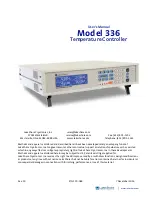
GS3
3
CALIBRATION
3
Calibration
Dielectric Permittivity
In some specific cases, a calibration that gives dielectric permittivity
(combined real and imaginary) for the GS3 is useful. The dielectric
of the medium,
ε
a
is the standard factory calibrated output of the
GS3 before applying a calibration.
Calibration for Soilless Media
The GS3 has been calibrated in media types including potting soil,
perlite and peat. The goal of these calibrations is to create a generic
calibration equation that will work in all types of each substrate, with
an accuracy of better than
±
5% volumetric water content (VWC). If
you need more accuracy, you can perform a media-specific calibration
to get the accuracy down to
±
1 to 2%. It is interesting to note that
the main difference between the calibrations is caused by the high
air volume in the organic soils that lowers the starting (dry media)
dielectric of the sensor. For more information on how to calibrate
your probes, please see
http://www.decagon.com/support
. Decagon
also has a calibration service, where we will perform the calibration
for a standard fee. Contact Decagon for more information about this
calibration service.
The calibration for several potting soils, perlite, and peat moss at
salinities ranging from 0 to
>
4 dS/m is given:)
V W C
(
m
3
m
3
) = 0
.
118
√
a
−
0
.
117
(5)
The calibration for mineral soils ranging from 0 to
>
5 dS/m is:
V W C
(
m
3
m
3
) = 5
.
89 x 10
−
6
ε
3
−
7
.
62 x 10
−
4
ε
2
+3
.
67 x 10
−
2
ε
−
7
.
53 x 10
−
2
(6)
9













































